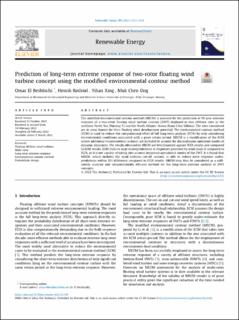| dc.contributor.author | El Beshbichi, Omar | |
| dc.contributor.author | Rødstøl, Henrik | |
| dc.contributor.author | Xing, Yihan | |
| dc.contributor.author | Ong, Muk Chen | |
| dc.date.accessioned | 2023-02-09T10:13:10Z | |
| dc.date.available | 2023-02-09T10:13:10Z | |
| dc.date.created | 2022-03-21T15:51:48Z | |
| dc.date.issued | 2022 | |
| dc.identifier.citation | El Beshbichi, O., Rødstøl, H., Xing, Y., & Ong, M. C. (2022). Prediction of long-term extreme response of two-rotor floating wind turbine concept using the modified environmental contour method. Renewable Energy, 189, 1133-1144. | en_US |
| dc.identifier.issn | 0960-1481 | |
| dc.identifier.uri | https://hdl.handle.net/11250/3049585 | |
| dc.description.abstract | The modified environmental contour method (MECM) is assessed for the prediction of 50-year extreme response of a two-rotor floating wind turbine concept (2WT) deployed in two offshore sites in the northern North Sea (Norway 5) and the North Atlantic Ocean (Buoy Cabo Silleiro). The sites considered are in areas known for their floating wind development potential. The environmental contour method (ECM) is used to reduce the computational effort of full long-term analysis (FLTA) by only considering environmental conditions associated with a given return period. MECM is a modification of the ECM where additional environmental contours are included to account for discontinuous operation modes of dynamic structures. The results obtained in MECM are benchmarked against FLTA results and compared to ECM results. ECM leads to large underpredictions of responses governed by wind loads if compared to FLTA, as it is not capable of taking into account important operational modes of the 2WT. It is found that MECM, which includes the wind turbines cut-off contour, is able to reduce most response underpredictions within 15% difference compared to FLTA results. MECM may thus be considered as a sufficiently accurate and computationally efficient method for the long-term extreme analysis of 2WT concepts. | en_US |
| dc.language.iso | eng | en_US |
| dc.publisher | Elsevier | en_US |
| dc.rights | Navngivelse 4.0 Internasjonal | * |
| dc.rights.uri | http://creativecommons.org/licenses/by/4.0/deed.no | * |
| dc.title | Prediction of long-term extreme response of two-rotor floating wind turbine concept using the modified environmental contour method | en_US |
| dc.title.alternative | Prediction of long-term extreme response of two-rotor floating wind turbine concept using the modified environmental contour method | en_US |
| dc.type | Peer reviewed | en_US |
| dc.type | Journal article | en_US |
| dc.description.version | publishedVersion | en_US |
| dc.rights.holder | The authors | en_US |
| dc.subject.nsi | VDP::Teknologi: 500 | en_US |
| dc.source.pagenumber | 1133-1144 | en_US |
| dc.source.volume | 189 | en_US |
| dc.source.journal | Renewable Energy | en_US |
| dc.identifier.doi | 10.1016/j.renene.2022.02.119 | |
| dc.identifier.cristin | 2011488 | |
| cristin.ispublished | true | |
| cristin.fulltext | original | |
| cristin.qualitycode | 1 | |

